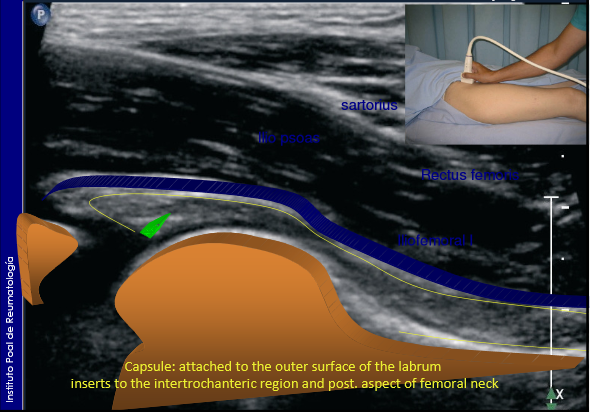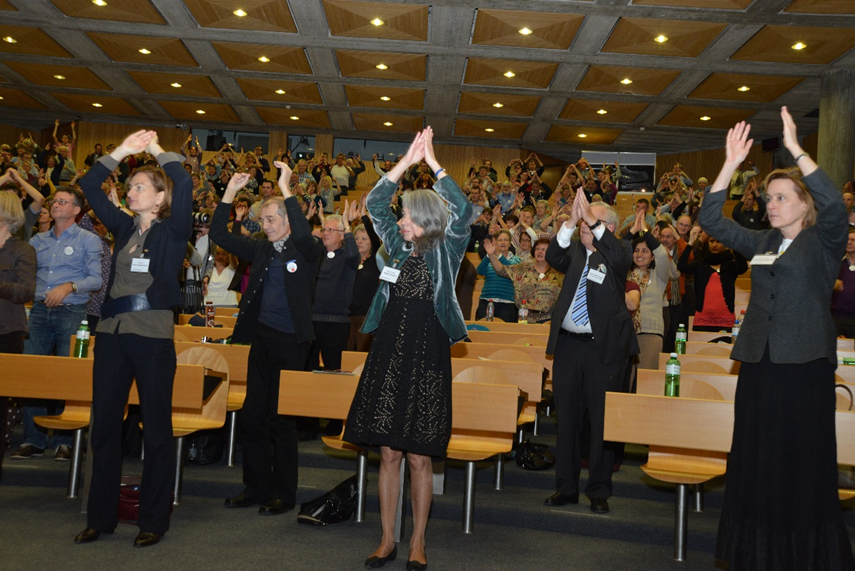axSpA, PsA and RA
Our research focuses on the most common types of arthritis: rheumatoid arthritis, axial spondyloarthritis and psoriasis arthritis.
Rheumatoid arthritis
Rheumatoid arthritis, earlier known as chronic polyarthritis, is a chronic systemic inflammatory disease that mainly affects the joints. It affects approx. 1% of the population, with an age peak between 40 and 60. Women are affected 3 times more than men. The causes of the disease are unknown. Genetic and environmental factors (smoking in particular) contribute to the development of the disease. The immune system is activated, triggering inflammation in the joints (synovitis). Untreated, this inflammation leads to the destruction of the joint and to the subsequent function impairment.
Current projects
Early Arthritis Recognition Clinic (EARC)
The early diagnosis of RA (rheumatoid arthritis) is paramount for the success of the treatment. Diagnostic delay within the area of Zurich is currently approx. 20 weeks. One of the main factors contributing to this delay is that patients often wait too long before consulting their GP.

Patients presenting in the early arthritis recognition clinic without clinical synovitis are monitored at regular intervals for 2 years if they are at high risk of developing rheumatoid arthritis (EULAR criteria).
This study, financed by the Swiss National Science Foundation, aims to examine direct relatives of patients with RA before the outbreak of the disease and to monitor them on a longer term. Although 1% of the population suffers rheumatoid arthritis, their relatives are affected 3-6 times more.
link to www.arthritis-checkup.ch

Published studies (selection)
The prevalence of anticitrullinated protein antibodies increases with age in healthy individuals at risk for rheumatoid arthritis. Alpizar-Rodriguez D, Brulhart L, Mueller RB, Möller B, Dudler J, Ciurea A, Walker UA, Von Mühlenen I, Kyburz D, Zufferey P, Mahler M, Bas S, Gascon D, Lamacchia C, Roux-Lombard P, Lauper K, Nissen MJ, Courvoisier DS, Gabay C, Finckh A. Clin Rheumatol. ;36:677-82, 2017.
Female hormonal factors and the development of anti-citrullinated protein antibodies in women at risk of rheumatoid arthritis. Alpizar-Rodriguez D, Mueller RB, Möller B, Dudler J, Ciurea A, Zufferey P, Kyburz D, Walker UA, von Mühlenen I, Roux-Lombard P, Mahler M, Lamacchia C, Courvoisier DS, Gabay C, Finckh A. Rheumatology (Oxford). 56:1579-85, 2017.
The SCQM program was founded in 1997 in Zürich as a quality management instrument of the treatment of rheumatoid arthritis. The input of data on disease activity, function, damage, quality of life etc. allows a targeted therapy and makes communication between patient and physician easier. The anonymised data is also used for research.

Published studies (selection)
Evolution of radiographic joint damage in rituximab-treated versus TNF-treated rheumatoid arthritis cases with inadequate response to TNF antagonists. Finckh A, Möller B, Dudler J, Walker UA, Kyburz D, Gabay C; physicians of the Swiss Clinical Quality Management for Rheumatoid Arthritis; physicians of SCQM-RA. Ann Rheum Dis. 71(10):1680-5, 2012
The long-term impact of early treatment of rheumatoid arthritis on radiographic progression: a population-based cohort study. Kyburz D, Gabay C, Michel BA, Finckh A; physicians of SCQM-RA. Rheumatology (Oxford). 50:1106-10, 2011.
Which subgroup of patients with rheumatoid arthritis benefits from switching to rituximab versus alternative anti-tumour necrosis factor (TNF) agents after previous failure of an anti-TNF agent? Finckh A, Ciurea A, Brulhart L, Möller B, Walker UA, Courvoisier D, Kyburz D, Dudler J, Gabay C; Arthritis. Ann Rheum Dis. 69:387-93, 2010.
Additional data on inflammatory joint changes is collected by ultrasonography in SCQM. Whether this might contribute to the optimal management of the disease remains unclear.

Published studies (selection)
Can Ultrasound Be Used to Predict Loss of Remission in Patients with RA in a Real-life Setting? A Multicenter Cohort Study. Zufferey P, Scherer A, Nissen MJ, Ciurea A, Tamborrini G, Brulhart L, Blumhardt S, Toniolo M, Möller B, Ziswiler HR; SONAR Group and the SCQM Foundation. J Rheumatol. 45:887-894, 2018.
Persistence of ultrasound synovitis in patients with rheumatoid arthritis fulfilling the DAS28 and/or the new ACR/EULAR RA remission definitions: results of an observational cohort study. Zufferey P, Möller B, Brulhart L, Tamborrini G, Scherer A, Finckh A, Ziswiler HR. Joint Bone Spine. 81:426-32, 2014.
The UPEDRA study (Prediction of erosive disease in early RA by ultrasound and cartilage biodegradation markers) is a collaboration between the Universities of Zurich and Basel. Newly diagnosed RA-patients are examined clinically as well as with x-ray, ultrasound and MRI at the beginning and during the progress of their treatment. This study takes place in close collaboration with the Clinical Trials Center RUZ.
Axial spondylarthritis
The axial spondylarthritis (axSpA; Morbus Bechterew) belongs to the group of spondyloathritis diseases, to which psorioarthritis and arthritic inflammatory diseases of the intestine also belong. The inflammation occurs in the axial skeleton (vertebral column and sacroiliac joint) as well as in the peripheral joints. The main characteristic is the inflammation at the base of the tendons and ligaments, a consequence of the activation of the immune system. Genetic factors (i.E. assosciation with the hereditary character HLA-B27), as well as environmental factors are involved in the development of the disease. Uncontrolled repair processes after inflammation recess can lead to an increased osteogenesis and bone bridges between the verterbrae. The progression of the disease can reduce considerably the mobility of the vertebral column.
Current projects
Since 2005 axSpA patients from all across Switzerland have been included in the SCQM-cohort. With >4’500 patients, this is the largest spondyloarthritis-cohort worldwide. The main aim is to capture validated parameters about disease activity, function, spinal damage and quality of life, for individualizing targeted therapy (treat-to-target principle). Taking part in SCQM plus using the SCQM-App improves the communication between patient and physician. The resulting data have led to many findings on how to optimize biologic treatment, gender differences, smoking, overweight and spinal osteoproliferation. Many other analyses are underway.

Published studies (selection)
TNF blockers inhibit spinal radiographic progression in ankylosing spondylitis by reducing disease activity: results from the Swiss Clinical Quality Management cohort. Molnar C, Scherer A, Baraliakos X, de Hooge M, Micheroli R, Exer P, Kissling RO, Tamborrini G, Wildi LM, Nissen MJ, Zufferey P, Bernhard J, Weber U, Landewé RBM, van der Heijde D, Ciurea A. Ann Rheum Dis. 77:63-69, 2018.
Response to Tumor Necrosis Factor Inhibition in Male and Female Patients with Ankylosing Spondylitis: Data from a Swiss Cohort. Hebeisen M, Neuenschwander R, Scherer A, Exer P, Weber U, Tamborrini G, Micheroli R, Wildi LM, Zufferey P, Nissen MJ, Villiger PM, Bernhard J, Finckh A, van der Horst-Bruinsma IE, Sieper J, Landewé R, van der Heijde D, Ciurea A. J Rheumatol. 45:506-512, 2018.
Tumor necrosis factor α inhibition in radiographic and nonradiographic axial spondyloarthritis: results from a large observational cohort. Ciurea A, Scherer A, Exer P, Bernhard J, Dudler J, Beyeler B, Kissling R, Stekhoven D, Rufibach K, Tamborrini G, Weiss B, Müller R, Nissen MJ, Michel BA, van der Heijde D, Dougados M, Boonen A, Weber U. Arthritis Rheum. 65:3096-106, 2013.
Hip involvement in axSpA seems associated with a worse prognosis, especially with regard to potential spinal radiographic progression. This question is being investigated with regular ultrasound examinations of the hip joints in patients within the SCQM program. The possible correlation is object of a long-term investigation.

All patients affected by axSpA confirm that physical exercise is essential! Scientific evaluation of the effect of regular exercise remains difficult. In addition to mobility exercises, cardiovascular training is important too. On the other hand, physical hard work is associated with a bad prognosis. To find out which type of exercise might be involved in accelerated spinal osteoproliferation is an important aim of our analyses. The studies are carried out in close collaboration with the ZAHW (Zürcher Hochschule für Angewandte Wissenschaften; Prof. K. Niedermann) and with the Ankylosing Spondylitis Association of Switzerland (SVMB).

Published study
Effect of cardiovascular training on fitness and perceived disease activity in people with ankylosing spondylitis. Niedermann K, Sidelnikov E, Muggli C, Dagfinrud H, Hermann M, Tamborrini G, Ciurea A, Bischoff-Ferrari H. Arthritis Care Res (Hoboken). 65:1844-52, 2013.
The Ankylosing Spondylitis Association of Switzerland (SVMB) carried out a large online questionnary with over 1’000 participants in 2016. The large amount of data are being scientifically analyzed within a master thesis.
A cohort of patients with axial spondylarthritis coexisting inflammatory bowel disease is being created in close collaboration with our colleagues at the Clinic for gastroenterology at USZ.
An alliance of 11 registries (including SCQM) are collaborating in axSpA research.
Psoriarthritis
(PsA) appears in 20%-30% of patients affected with psoriasis. The pattern of manifestation is, in contrast to rheumatoid arthritis, much more varied. As well as peripheral joint inflammation, this disease can also show inflammation at the base of the tendons (enthesitis) swelling of the fingers or thumbs (dactylitis) or an affliction of the sacroiliac joint and the vertebral column (spondylarthritis). Collaboration with dermatologists is essential for the treatment of this disease
Current projects
The psoriatic arthritis-cohort is the youngest within the SCQM-program. As with RA and axSpA, the object is the quality management of the treatment and a personalized, targeted therapy. Different PsA-studies are currently being processed.

With great effort across Switzerland, the possibility of a large randomised, controlled study in PsA within the SCQM program is being evaluated.


